9+ Sample Renovation Contracts
-
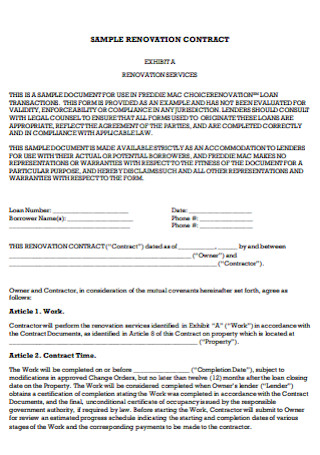
Sample Renovation Contract
download now -
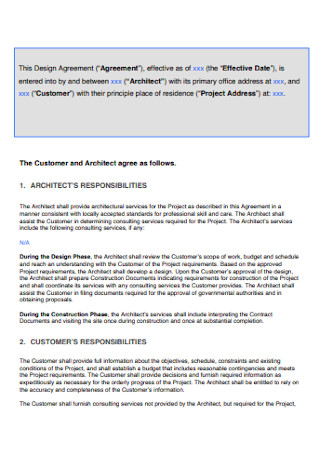
Renovation Design Contract
download now -

Renovation Construction Contract
download now -
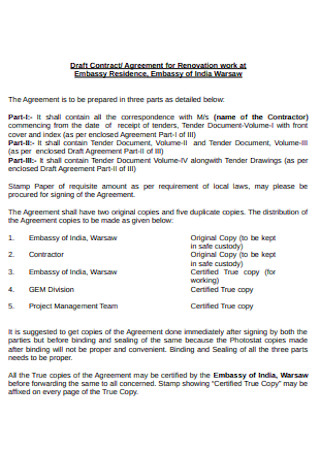
Renovation Work Contract
download now -
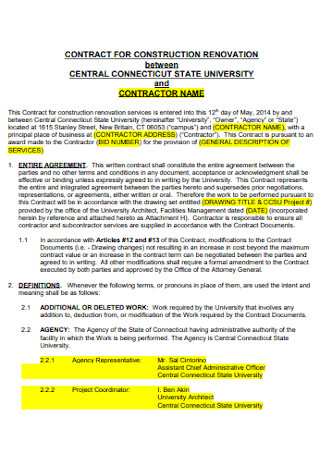
Contract for Construction Renovation
download now -
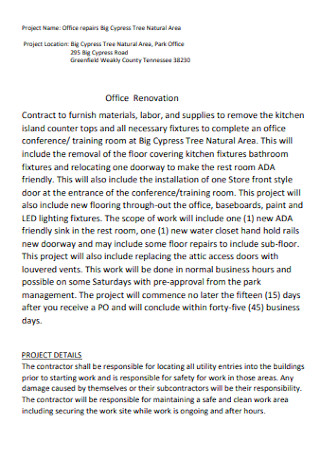
Office Renovation Contract
download now -

Contractor and Home Renovation
download now -
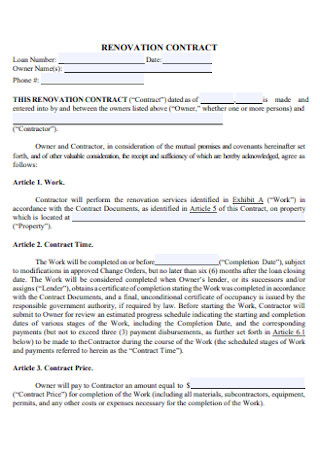
Standard Renovation Contract
download now -
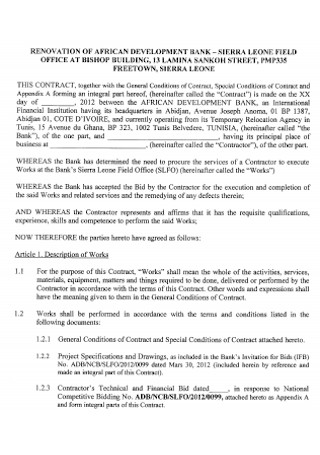
Bank Renovation Contract
download now
FREE Renovation Contract s to Download
9+ Sample Renovation Contracts
What Is a Renovation Contract?
Key Elements Included in a Renovation Contract
Step by Step Process in Creating a Renovation Contract
FAQs
What are the Most Common Types of Arrangement in Terms of Pricing?
What Are the 5 R’s of Procurement?
What is the Difference between Procurement and Purchasing?
What Is a Renovation Contract?
A renovation contract is a contract agreement between two parties. This is between a contractor and a client. This will state the different terms and conditions as well as the services that are to be provided by the contractor. It is a must that this is checked and reviewed down until the minute details. This will outline the different roles and responsibilities of the contractor and the client. This can also be referred to as a remodeling contract or in some cases home improvement contract.
Key Elements Included in a Renovation Contract
Step by Step Process in Creating a Renovation Contract
Step 1: Select a Format
The first step would be to select a template or format. It is important that a contract is type not handwritten. This will protect parties from signing a contract that lacks precision. This will also help in easy checking for errors.
Step 2: Provide an Introductory Statement
This will identify what type of contract it is. This will also state the basic information of the contractor or the company. This will state the name of the contractor, the contact information of the contractor as well as their address. If it applies also include their license number. On the other hand, it is also a must to include the name of the client or the one who availed the service. Included also are their contact information and address.
Step 3: Identify the Different Terms
The next step would be to identify the terms. This will clearly state what are the work or the services that are to be provided by the contractor. This should state also the services that are not included or not under that service. This would also identify the different tools, pieces of equipment and raw materials that are needed in order to complete the project. A contract should clearly state who is in charge of buying the materials and who is in charge of checking and maintaining them.
Step 4: Identify the Schedule of the Project
Next thing to do is to ask when will the project commence? It is important to set out a date when the project will actually start. It is also a must to have an estimated end date of the project. With knowing this, the designing and implementation of the construction schedule will be more detailed and effective. This will help in focusing the attention in the different stages of construction or the different key activities that are to be performed.
Step 5: Include the Supporting Documents
It is important to have supporting documents. A renovation or remodeling may not commence without the necessary documents like a building permit. Other supporting documents are the different licenses. The contract should clearly state who is responsible for securing those permits and licenses. This may also include the different warranties that are given to the client or the owner of the property.
Step 6: Discuss the Additional Information
During the whole duration of the renovation process, it is a must that a worker has a place to stay. In big and complex projects, it is a must that there is an area where a barracks will be built in order for the laborers to sleep. It is also a must that there is a place where they can eat. Other additional information that is crucial to be discussed are the different utilities for everyday use. These utilities are electricity and water.
Step 7: Identify the Cost
This will mostly depend on the agreement between the client and the contractor. There are different methods or approaches in determining the total cost of the construction. However, it is important to state that in the contract. It is also a must to include the estimated total cost of the project. This must cover everything from the compensation of the workers down until the different materials, tools and equipment that will be bought and used in order to finish the construction or renovation. The contract must also state the schedule of payment. This should clearly state the down payment that is required and the succeeding payments.
Step 8: Review, Finalize and Sign
Lastly, before publishing or publicizing the document, it is a must to check and review the document for any errors. It is a must that both the client and the contractor have their own copy of the document. After reviewing and finalizing the contract, both parties must affix their signature along with the date in order to finalize and legalize the agreement. In most cases, this part will include the concluding statement that will clearly state that both the client and the contractor have fully read and agreed to the terms in the contract. This will state that they acknowledge what is written in the contract.
In creating a contract, it is important to assess the different terms and make sure that they are in compliance with the law of the local government or the state. A tip that may help is to consult a lawyer or an adviser in order to make sure that you are not violating any rules and guidelines. This is why it is imperative that the supporting documents like building permits are available and secured.
FAQs
What are the Most Common Types of Arrangement in Terms of Pricing?
Lump sum – This can also be referred to as fixed price. This is the simplest type of contract wherein the contractor will be paid depending on the agreement between the two parties.
Cost or cost-plus – The contractor will be paid according to the cost of the project plus a fee to cover profit and other non reimbursable fees.
Unit price – This can also be referred to as measure and value. The contractor will be paid depending on the actual quantity of the finished product or output. It will then be multiplied by the agreed per unit prices.
Time and materials – This is a combination of unit price and cost. The contractor will be paid depending on the actual cost of the materials and the agreed compensation of the laborers. Another thing that will be a factor here is the price of the tools and pieces of equipment. The client will generally pay the contractor based on the effort.
What Are the 5 R’s of Procurement?
There are 5 rights in the process of procurement. These 5 r’s will be the guidelines in order to provide the organization or the process with the right inputs. The 5 r’s are:
The right quality:
This means that the products or raw materials are of good quality and up to the standards. This makes sure that the process will not be hindered due to weak materials.
The right quantity:
This means that there should be a sufficient amount of materials in order to complete the project. This makes sure that the operation will not stop because of lack of materials.
The right place:
This means that the ordered materials are to be delivered at the right place to not hinder the operational process.
The right time:
The materials should be delivered not only at the right place but also at the right time. This will make sure that the materials are delivered when they are needed.
The right price:
In order to maximize the profit, the prices of the goods and services must be at a reasonable price.
It is important that to achieve these 5 rights, the company or business organization must find the right supplier.
What is the Difference between Procurement and Purchasing?
More often than not, procurement and purchasing are used interchangeably. Though they may share some similarities there is a bigger meaning and difference between the two. A purchasing may be considered as a process or phase of procurement. Purchasing is the process of buying or ordering a supply. It is a short-term goal. On the other hand, procurement is a bigger and longer process. It is a strategic method of acquiring goods and services, it also helps in building a long-lasting relationship with the supplier. The main focus of procurement is to source or look for quality products and raw materials.
A renovation contract is an agreement between the client and the contractor. This document may be used in the same way as a construction proposal. This should clearly outline the different services that are to be performed during the remodeling or construction process. It is important that a renovation contract will identify the activities or tasks that are included in the agreement as well as the different tasks that are not included. This will help in order to avoid disputes between the two parties. This is also a legally binding contract so it is important that the contract is in compliance with the local or state law.
Try the different templates that are available above in order to have an outline of what is needed in order to have a detailed and solid renovation contract.
